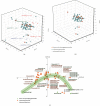Chemical Distance Measurement and System Pharmacology Approach Uncover the Novel Protective Effects of Biotransformed Ginsenoside C-Mc against UVB-Irradiated Photoaging
- PMID: 35186187
- PMCID: PMC8850047
- DOI: 10.1155/2022/4691576
Chemical Distance Measurement and System Pharmacology Approach Uncover the Novel Protective Effects of Biotransformed Ginsenoside C-Mc against UVB-Irradiated Photoaging
Abstract
Long-term exposure to ultraviolet light induces photoaging and may eventually increase the risk of skin carcinogenesis. Rare minor ginsenosides isolating from traditional medicine Panax (ginseng) have shown biomedical efficacy as antioxidation and antiphotodamage agents. However, due to the difficulty of component extraction and wide variety of ginsenoside, the identification of active antiphotoaging ginsenoside remains a huge challenge. In this study, we proposed a novel in silico approach to identify potential compound against photoaging from 82 ginsenosides. Specifically, we calculated the shortest distance between unknown and known antiphotoaging ginsenoside set in the chemical space and applied chemical structure similarity assessment, drug-likeness screening, and ADMET evaluation for the candidates. We highlighted three rare minor ginsenosides (C-Mc, Mx, and F2) that possess high potential as antiphotoaging agents. Among them, C-Mc deriving from American ginseng (Panax quinquefolius L.) was validated by wet-lab experimental assays and showed significant antioxidant and cytoprotective activity against UVB-induced photodamage in human dermal fibroblasts. Furthermore, system pharmacology analysis was conducted to explore the therapeutic targets and molecular mechanisms through integrating global drug-target network, high quality photoaging-related gene profile from multiomics data, and skin tissue-specific expression protein network. In combination with in vitro assays, we found that C-Mc suppressed MMP production through regulating the MAPK/AP-1/NF-κB pathway and expedited collagen synthesis via the TGF-β/Smad pathway, as well as enhanced the expression of Nrf2/ARE to hold a balance of endogenous oxidation. Overall, this study offers an effective drug discovery framework combining in silico prediction and in vitro validation, uncovering that ginsenoside C-Mc has potential antiphotoaging properties and might be a novel natural agent for use in oral drug, skincare products, or functional food.
Copyright © 2022 Xiao-yi Liu et al.
Conflict of interest statement
The authors declare that there is no conflict of interest regarding the publication of this paper.
Figures











References
-
- Kammeyer A., Luiten R. M. Oxidation events and skin aging. Ageing research reviews . 2015;21 - PubMed
MeSH terms
Substances
LinkOut - more resources
Full Text Sources
Medical
Miscellaneous

